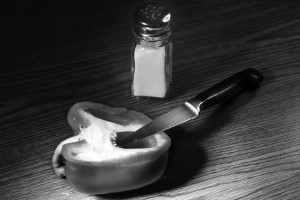I decided that it would be interesting to assemble a set of “My Favorite Photographs.” Perhaps I will share some of these with you. When you test your memory with the question: which photographs of all the thousands that you have seen rise to, say, the top twelve favorites, your mind organizes itself and first asks: who are your favorite photographers. That seems an easy question. In my youth two photographers inhabited the Cathedral of the Most Holy. These were Ansel Adam and Edward Weston.
These two sainted figures set the standard for what could be done with black and white photography. That is, if you were willing to, like a novice or initiate, learn the black and white arts of the fine print. It is a standard to which I, and my generation of amateur phoyographers, continue to strive. So then the problem becomes simple. For Ansel Adams, it’s “Moonrise Hernandez, NM, 1941” and for Weston it’s “Pepper No. 30., 1930”
Please take a moments and follow the link to have a look at “Pepper No. 30.” It is a very sensual pepper. The two halves seem to be caressing one another as two lovers. It’s a wonderful picture. So I clipped it out electronically and pasted it into my little collection of favorites. This is when it struck me. I still like it, and Edward Weston is certainly still one of my top favorites. But Pepper No. 30 no longer holds special favorite status magic for me. It was a revelation for me.
I found myself rushing to my bookshelf and dusting off the little 1971 Aperture monograph “Edward Weston.” Relieved, I found that I still love Weston. His “Nude in the Dunes, 1930,” his curled up “Nude, 1936,” and his “Two Shells, 1927,” still ring true and wonderful. But “Pepper No. 30,” not so much! It made me wonder what had happened, why had this image lost its spell on me?
I looked up in the Aperture monograph what Weston himself wrote about “Pepper No. 30.”
“It is classic, completely satisfying, – a pepper – but more than a pepper: an abstract, in that it is completely outside subject matter. It has no psychological attributes, no human emotions are aroused: this new pepper takes me beyond the world we know in the conscious mind.”
Really? It was then that I understood. It is not that the pepper was any less sensuous or abstract. Like any original, its impact had become lost when copying became overwrought. “Pepper No. 30,” and equally wonderful, “Cabbage Leaf, 1931,” have been copied so much that we have become immune to their impact. Indeed, I’ve probably seen “Pepper No. 30” reproduced over a thousand times. The entire kitchen: carrots, turnips, cabbages, and pasta have been imaged so many times that we no longer care. Even in film we have the famous gastronomical seduction in Tony Richardson’s screen adaptation of Henry Fielding’s, “Tom Jones,” and Ken Russel’s rendering of D. H. Lawrence’s essay on “The Proper Way to Eat a Fig in Society,” in his “Women in Love.” This marvelous little photograph that I once revered and held in sainted status had been murdered in the cathedral.
Weston describes how the pepper was beginning to lose its freshness, that this was the last day that it would be worth photographing. So I suppose we must assume that it was ultimately eaten. For me, I am pleased that I opened the monograph. Sometimes there is a special intimacy to looking at photographs on paper, and I find that Edward Weston still occupies the pantheon of my personal greats. Looking at his images, I realize how much there is to learn and how much he has to teach us.


Not having seen the pepper or cabbage leaf in years I was again struck by the interesting form and beauty of these images. I didn’t feel the loss of feeling and impact that you describe. Curiously, I find the “Nude, 1936” to have an abstract quality that leaves me with no human emotion, to quote Weston. Some images that are repeated frequently certainly lose their effect over time but others don’t and I think it is hard to predict which ones will fall into which group.
My understanding is that “Moonrise” was photographed around 4 pm and the magic of the apparent night scene was created in the darkroom (like many of his works). It is still amazing. No murder there.
I agree that the nudes are perfect abstractions. They don’t evoke emotion just peaceful centered-ness. What appeals to me about “Nude in the Dunes, 1930” is the perfect adherence to the “Golden Rule of Thirds.” Here, in Weston’s hands, something remarkable happens. The women appears to be slipping in the sand. You keep wanting to slide her back up to the center. This creates a fabulous dynamic tension. In contrast, “Nude, 1936” is beautifully folded and stable. Both work. I’m not sure that I would have had the artistic eye to place “Nude in the Dunes, 1930” as Weston did.
As for “Moonrise,” it speaks for itself. Just incredible!
I agree after re-looking at nude in dune that there is some tension created by the mental urge to push up higher.